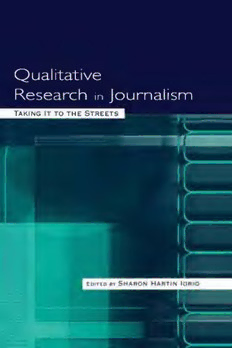
Taking It to the Streets: Qualitative Research into Journalism PDF
Preview Taking It to the Streets: Qualitative Research into Journalism
Qualitative Research in Journalism Taking It to the Streets Qualitative Research in Journalism Taking It to the Streets This page intentionally left blank Qualitative Research in Journalism Taking It to the Streets Edited by Sharon Hartin Iorio Wichita State University 3 Routledge Taylor & Francis Group New York London Copyright © 2004 by Lawrcncc Erlbaum Associates, Inc. All rights reserved. No part of this book may be reproduced in any form, by photostat, microform, retrieval system, or any other means, without prior written permission of the publisher. First published by Lawrcncc Erlbaum Associates, Inc., Publishers 10 Industrial Avenue Mahwah, NJ 07430 This edition published 2011 by Routlcdgc Rout ledge Routledge Taylor & Francis Group Taylor & Francis Group 711 Third Avenue 2 Park Square, Milton Park New York, NY 10017 Abingdon, Oxon OX14 4RN Cover design by Kathryn Houghtaling Lacey Library of Congress Cataloging-in-Publication Data Qualitative research in journalism : taking it to the streets /edited by Sharon Hartin Iorio. p. cm. Includes bibliographical references and index. ISBN 0-8058-4398-1 (cloth : alk. Paper) ISBN 0-8058'4399-X (pbk.: alk. paper) PN4784.R38T35 2003 070.407*2—dc21 2003046235 CIP The editor dedicates this volume to the journalists who provided interviews, gave their time to this project in countless ways, and work daily to provide accurate information to the general public This page intentionally left blank Contents Foreword—Jay Rosen Preface About the Contributors Part I Qualitative Method Journalism—Sharon Hartin lorio Connected Research: The Chicago School Precedent—Lewis A. Friedland and Kathryn B. Campbell The Changing News Paradigm: From Objectivity to Interpretive Sufficiency—Clifford G. Christians Part II Qualitative Case Study Methods in Newsroom Research and Reporting: The Case of the Akron Beacon Journal— Tanni Haas Focus Groups Newsroom Style—Susan Willey Oral and Life Histories: Giving Voice to the Voiceless—Renita Coleman viii CONTENTS 7 Focused Interviews—Sharon Hartin lorio 109 8 Ethnographic Journalism—Janet M. Cramer and Michael 127 Me Devitt 9 Inventing Civic Mapping—Kathryn B. Campbell 145 10 Textual Analysis in Journalism—John L. “Jack” Morris 163 11 Scientists and Storytellers: The Imperative of Pairing 175 Qualitative and Quantitative Approaches in Communication Research—Swsan Schultz Huxman and Mike Allen 12 Academic/Professional Partnerships: Newsrooms 193 and Community—Jan Schaffer Glossary 213 Author Index 227 Subject Index 233 Foreword When I look over the landscape of journalism today, I see changes that are al most geological in kind—the plates are shifting, the continent grinds in motion. Familiar features arc still there, hut from basin to range there are strange forma tions, and new aspects appear. Below the surface much goes on. The ground rises where before there was nothing to build on. Old ground cracks and sinks. The hardest problem in journalism today may be to map it, to draw borders around the practice and define what’s within or beyond. Is there an audience for serious news? One of the ways we struggle is to map the space available for jour nalism. The imagined line between “news” and “entertainment” is another. Does the border separating journalism from other creative treatments of real ity by the media complex run through counties, or through companies, or sec tions of the newspaper, portions of the broadcast schedule, segments in the Today Show? Probably it runs through individuals—journalists—producers of news who sway one way, then another; feel commercial pressure, resist it, make space for themselves and for journalism, then lose it, regain it here, give it up over there. Where is journalism in a company like the American newspa per giant, Gannet, which is sometimes devoted to the practice with, let us say, half a heart? Where is “journalism” in that screaming empire known as Fox? Somewhere in the mix. Difficulties in saying who is a journalist make for unstable ground in the prac tice. When did former political operative Tim Russert become one, and why is Net gossip Matt Drudge not one? We may be used to questions like that. But now with the Internet the possibility of opening a solo practice in journalism has returned, and we are little used to that. Put up a website with good reporting and commentary and you may be successfully practicing journalism, even though no ix
